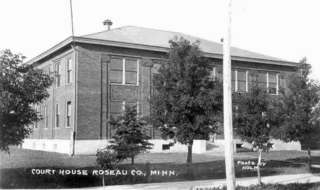
Roseau County is a county in the northwestern part of the U.S. state of Minnesota, along the Canada–US border. As of the 2020 census, the population was 15,331. Its county seat is Roseau. Roseau County borders the Canadian province of Manitoba.

The Clearwater Masonic and Grand Army of the Republic Hall is a historic building in Clearwater, Minnesota, United States, constructed in 1888. It has served as a meeting hall for both a local Grand Army of the Republic (GAR) post, and a local Masonic Lodge, with commercial space on the ground floor. It was listed on the National Register of Historic Places in 1979 under the name Clearwater Masonic Lodge–Grand Army of the Republic Hall for having local significance in the themes of architecture and social history. It was nominated for its association with the fraternal organizations of Clearwater and many other rural Wright County communities that, in the words of historian John J. Hackett, "provided leadership, direction, and contributions to the county's political, educational, patriotic, and social life."
The Czech-Slovak Protective Society (CSPS), which became the Czecho Slovakian Association, was an organization supporting the welfare of Czech and Slovak immigrants to the United States. The Czech-Slovak Protective Society started as an insurance services organization. It was once the largest Czech-American freethought fraternity in the United States.
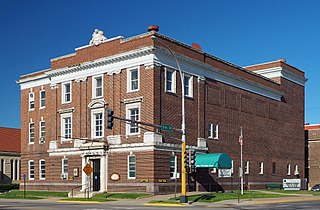
The Winona Masonic Temple is a historic Masonic Temple in Winona, Minnesota, United States, completed in 1909. Many local civic and business leaders were members of the lodge. Containing a large ballroom and other meeting space, the building was an important venue in Winona for both Masonic activities and general public events. The Winona Masonic Temple was listed on the National Register of Historic Places in 1998 for having state-level significance in the themes of art and social history. It was nominated as the headquarters of a fraternal organization important to Winona's civic and social development, and for containing Minnesota's largest collection of Masonic theatre backdrops and stage equipment.

Yukon, Oklahoma's original Czech Hall was built in 1899 by early Czech settlers who were members of Sokol Karel Havliček Lodge and ZCBJ Lodge Jan Žižka No. 67. That building was rebuilt using the materials from the original building in order to have a larger building in 1925. That structure is standing today. It was originally known as the Bohemian Hall, with its name later changed to Yukon Czech Hall.

The New Richland Odd Fellows Hall is a historic Independent Order of Odd Fellows (IOOF) clubhouse in New Richland, Minnesota, United States, built in 1902. It was listed on the National Register of Historic Places in 2006 under the name Strangers Refuge Lodge Number 74, IOOF for its local significance in the themes of entertainment/recreation and social history. It was nominated for being the home of a large and important local fraternal organization, and for serving as a venue for a wide range of other groups and events. The building now houses the New Richland Public Library.
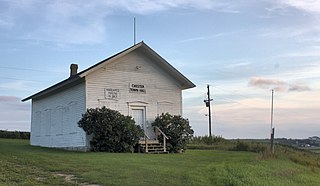
The Bear Valley Grange Hall is a historic meeting hall in Chester Township, Minnesota, United States. It was built in 1874 for the exclusive use of a local chapter of the National Grange of the Order of Patrons of Husbandry, an early farmers' advocacy group and fraternal organization. The chapter folded in the 1880s and the building has been used since as the Chester Town Hall. It was listed on the National Register of Historic Places in 1989 for having local significance in the theme of social history. It was nominated for being the only surviving Grange hall in Wabasha County—and one of only a few in Minnesota—and a rare example of a purpose-built Grange hall, as most chapters met in existing spaces like schools.

Crescent Grange Hall #512 is a former meeting hall of the Grange agricultural society in Linwood Township, Minnesota, United States. It was built from 1881 to 1882 by a chapter of the State Grange of Minnesota, the first state-level subdivision of the National Grange. It was listed on the National Register of Historic Places in 1979 for its local significance in the themes of agriculture and social history. It was nominated for being a well preserved example of an early meeting hall built by a subordinate Grange.
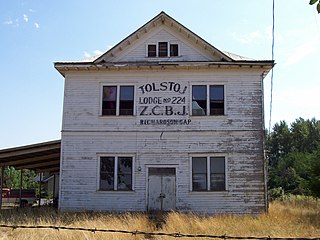
The Z.C.B.J. Tolstoj Lodge No. 224, also known as Bohemian Hall or Tolstoj Sokol Lodge, is a historic building in rural Linn County southeast of Scio, Oregon, United States, that was built in 1911. It was listed on the National Register of Historic Places on September 14, 1995. It historically served as a meeting hall for the Czech community. The lodge organized a Czech school, in addition to hosting concerts, dances, Sokol events and Fourth of July celebrations.

The Rad Plzen cis. 9 ZCBJ (SD10-6) is a building located in Morse Bluff, Nebraska that was built in 1911. It was listed on the National Register of Historic Places on March 20, 1986. The building historically served as a meeting hall for the Czech community. It was the meeting hall for the ZCBJ Lodge Plzen, a branch of the Zapadni Ceska Bratrska Jednota. The ZCBJ Lodge Plzen was originally organized on June 6, 1880 as a branch of the Czech-Slovak Protective Society, but was incorporated into ZCBJ in 1897.

The ZCBJ Lodge No. 46, also known as Bohemian Hall, is an historic building located in Prague, Oklahoma that was built in 1917. It was listed on the National Register of Historic Places on March 8, 1984. The building historically served as a meeting hall for the Czech community, hosting a Zapadni Ceska Bratrska Jednota lodge that was the oldest Czech fraternal order in Oklahoma. The lodge was originally organized in 1891 as a branch of the Czech-Slovak Protective Society, but was incorporated into Zapadni Ceska Bratrska Jednota in 1897.

The Z. C. B. J. Hall, also known as Bohemian Hall or Zapadni Cesko Bratrske Jednota Hall, is an historic building located near Arthur, Wisconsin that was built in 1907. It was listed on the National Register of Historic Places on June 25, 1992. It historically served as a meeting hall for the Czech community.

Z.C.B.J. Opera House is an historic building located in Clarkson, Nebraska, United States, that was built in 1913 by the Zapadni Ceska Bratrska Jednota, or Western Bohemian Fraternal Association. It was listed on the National Register of Historic Places on September 28, 1988. The building serves as a meeting hall for the Czech community. It has hosted operas, dances, lectures, films and Czech heritage events.

The Rad Sladkovsky lodge, also known as Pishelville Hall, is a building located near Verdigre, Nebraska that was built in 1884. It was listed on the National Register of Historic Places on June 29, 1982. The building historically served as a meeting hall for the Czech community, hosting a Zapadni Ceska Bratrska Jednota (ZCBJ) lodge that was the oldest Czech fraternal order in Nebraska. The lodge was originally organized as a branch of the Czech-Slovak Protective Society, but was incorporated into the ZCBJ in 1897.

The Western Fraternal Life Association, previously known as Zapadni Ceska Bratrska Jednota is a fraternal benefit society and financial services organization in the United States. The association has its roots in the Czechoslovak immigrant community of the 19th century. It was once the second largest Czech-American freethought fraternity in the United States.

The Western Bohemian Fraternal Union Hall is a historic clubhouse in Meadowlands Township, Minnesota, United States. It was built in 1925 as a meeting hall for a lodge of the Western Bohemian Fraternal Union, a society of Czech Americans. The hall also served as a host for Sokol gymnastics events. The hall was listed on the National Register of Historic Places in 1986 for its local significance in the themes of European ethnic heritage and social history. It was nominated for being a long-serving rural venue for the preservation of Czech American culture and heritage.
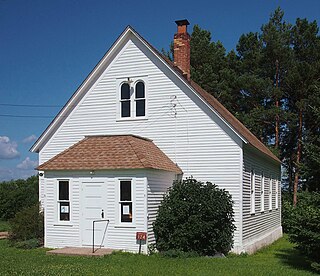
The Cokato Temperance Hall is a historic clubhouse built in 1896 in Cokato Township, Minnesota, United States, to serve as an alcohol-free social center in a rural Finnish American community. It was constructed by a local temperance society at a rural crossroads which became known as Temperance Corner. The building was listed on the National Register of Historic Places under its full Finnish name Cokaton P.R.S. Onnen Toivo Raittiusseura in 1976 for its local significance in the themes of European ethnic heritage and social history. It was nominated for its association with the temperance movement and importance to the cultural life of an immigrant community. The hall is now maintained by the Cokato Finnish American Historical Society, which has moved other historical structures nearby to form the Finnish Pioneer Park.

Lodge Zare Zapadu#44, known locally as Yellow Brick Hall and also known as Bohemian Brick Hall and Z.G.B.J. Council Hall #44, is a historic clubhouse of the Zapadni Ceska Bratrska Jednota serving the Czech-American community in rural Freeborn County, Minnesota, United States.

Charles Thompson Memorial Hall is a historic clubhouse of Deaf culture in Saint Paul, Minnesota, United States. Built in 1916, it was the first social club in the nation designed exclusively for the deaf.





















